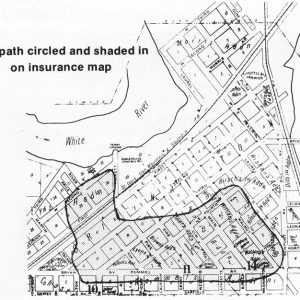calsfoundation@cals.org
Newport Fire of 1926
A devastating fire in Newport (Jackson County) on March 1, 1926, destroyed some thirty city blocks and caused significant damage, though only one life was lost.
The conflagration began just after 2:00 p.m. on March 1 when a spark from the flue of an African American’s cabin on the White River near the V. O. Jones Lumber Company caught its roof on fire, with flames soon jumping to the lumber yard, where a half dozen blazes started. From there, the fire ignited the homes of several other Black families living beside the White River before reaching the stave yards of the Merryman Cooperage Company; the fire raced from there to several other homes.
“A high west wind was blowing and the flames spread with startling rapidity,” the Arkansas Gazette reported. The fire soon reached Robinson’s Grocery, the Hays Motor Company, and a dozen buildings on Front Street before veering to the northeast, “cutting a swath roughly three blocks wide and one-half mile long, destroying some of the finest homes in the city.”
Fire departments in Walnut Ridge (Lawrence County), Jonesboro (Craighead County), Tuckerman (Jackson County), Batesville (Independence County), and Little Rock (Pulaski County) sent firefighters to help the hard-pressed Newport Fire Department, though by the time the Little Rock team arrived around 6:30 p.m., the blaze had been contained. American Legion members patrolled the area that night until National Guard troops could arrive and provide security.
The Gazette reported “30 city blocks swept practically clean” in an area roughly bounded by the White River on the west, Remmel Avenue on the east, Hazel Avenue on the north, and Chastain’s Addition on the south. Around 325 buildings were destroyed in addition to the Jones lumber yard and Merryman stave yard. Three African American churches—one African Methodist Episcopal and two Baptist—were lost to the flames. Total losses were estimated at $1.5 million, or $23.18 million in 2021 dollars. The sole fatality of the raging fire, a ninety-year-old Black woman named Mary Johnson, died of her injuries the next day.
The Red Cross set up a tent city to assist the 2,000 people left homeless by the fire as donations poured in from around the state and region. The Red Cross remained in Newport until April 30. They helped 313 of the 639 families affected by the fire, with their activities financed by $48,577.21 in donations.
While there does not appear to have been an official report on the fire, the Little Rock Lumbermen’s Club took out an advertisement in the April 11, 1926, Gazette to present the results of its independent “investigation,” which posited that high winds and faulty water pressure were largely to blame for the disaster, not the houses’ building materials: “With a fierce wind, estimated at 40 miles velocity, solid sheets of flame were carried 100 to 150 feet, with the intense heat and flames in many cases setting fire to the SIDE WALLS of buildings, without coming in contact with the roof,” the ad stated. After declaring that around “ONE-THIRD of the buildings lost had other than wooded shingles, and they burned just the same” the lumbermen concluded that “Edge-Grain Cedar Shingle is equally fire resistant as the average grade of composition shingle…and is far better in LEAK-PROOFNESS.”
For additional information:
Craig, Robert D. “Newport Fire of 1926.” Stream of History 46 (December 2013): 3–11.
Little Rock Lumbermen’s Club advertisement, Arkansas Gazette, April 11, 1926, p. 10.
“Relief Work at Newport Begun.” Arkansas Gazette, March 3, 1926, p. 1.
“Red Cross Fire Relief Work at Newport Ended.” Arkansas Gazette, April 30, 1926, p. 8.
“Thousand Persons Are Made Homeless When 20 Blocks of Residence Section of City of Newport Are Razed by Fire.” Arkansas Gazette, March 2, 1926, pp. 1, 18.
Mark K. Christ
Central Arkansas Library System
 Newport Fire
Newport Fire  Newport Fire Map
Newport Fire Map 




Comments
No comments on this entry yet.